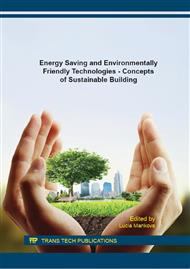p.315
p.323
p.331
p.339
p.347
p.355
p.363
p.371
p.379
Analysis of Energy Consumption in Building with NZEB Concept
Abstract:
The trend in the components of residential buildings is low energy demand buildings in relation to the minimum costs spent by users for their operation. The main aim of their construction is to improve the energy economy of buildings, to reduce the environmental load in energy consumption, to improve the quality of the interior, to ensure the minimum cost level in the operation of buildings and their maintenance in the life cycle. The consequence of increased energy prices and the possible implementation of tax policies in the countries of Europe is more frequently designing and implementing energy self-contained buildings. This means that energy necessary for the general use of a building can be produced in it to certain extent. The concept of such buildings is not only in high quality heat insulating properties, but also in suitable installed devices utilizing alternative sources. The objective indicator of saving and proof of the required level of a building is an analysis of its real energy consumption. The paper analyzes the energy consumption in a specific house which, in the design phase, met the criteria for designing a nearly zero energy building. The analyzed building has a high thermal protection and uses photovoltaic energy as an alternative source. The main aim is to evaluate the concept of the designed nearly zero energy building and to assess it in relation to the really consumed energy.
Info:
Periodical:
Pages:
347-354
Citation:
Online since:
January 2016
Authors:
Price:
Сopyright:
© 2016 Trans Tech Publications Ltd. All Rights Reserved
Share:
Citation:


